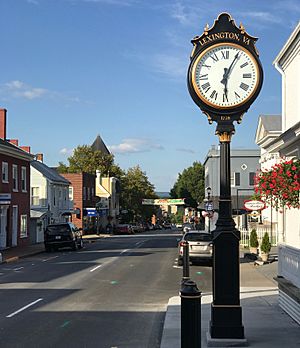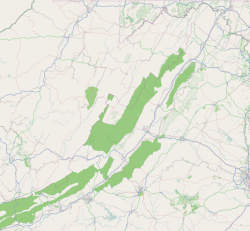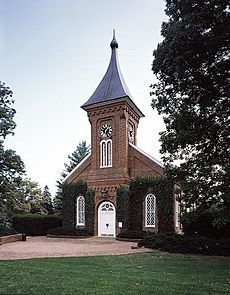Lexington, Virginia facts for kids
Quick facts for kids
Lexington, Virginia
|
|
|---|---|

Main Street, Lexington, Virginia
|
|

Lexington in the Commonwealth of Virginia
|
|
| Country | United States |
| State | Virginia |
| County | None (independent city) |
| Area | |
| • Total | 2.52 sq mi (6.54 km2) |
| • Land | 2.50 sq mi (6.47 km2) |
| • Water | 0.03 sq mi (0.07 km2) |
| Elevation | 1,063 ft (324 m) |
| Population
(2020)
|
|
| • Total | 7,320 |
| • Density | 2,905/sq mi (1,119.3/km2) |
| Time zone | UTC−5 (Eastern (EST)) |
| • Summer (DST) | UTC−4 (EDT) |
| ZIP Code |
24450
|
| Area code(s) | 540 |
| FIPS code | 51-45512 |
| GNIS feature ID | 1498506 |
| Website | Lexington, Virginia |
Lexington is a special kind of city in Virginia, United States. It's called an independent city. This means it's not part of any county.
In 2020, about 7,320 people lived there. Lexington is the main town for Rockbridge County. It is located in the beautiful Shenandoah Valley. The city is about 57 miles (92 km) east of the West Virginia border. It's also about 50 miles (80 km) north of Roanoke, Virginia.
Lexington was first settled in 1778. It is famous for being home to two important schools: the Virginia Military Institute and Washington and Lee University.
Contents
- Discovering Lexington's Past
- Exploring Lexington's Geography and Climate
- Who Lives in Lexington? (Demographics)
- Lexington's Economy: How People Make a Living
- Fun Places to Visit in Lexington
- Media and Communication in Lexington
- Getting Around Lexington (Transportation)
- Movies Filmed in Lexington
- Famous People from Lexington
- Images for kids
- See also
Discovering Lexington's Past
Lexington got its name in 1778. It was the first place in America named after Lexington, Massachusetts. That town is famous because the first shot of the American Revolution was fired there. This event is often called the "shot heard round the world."
Lexington During the Civil War
During the American Civil War, Union General David Hunter led an attack on the Virginia Military Institute. Two important figures from the Civil War, Robert E. Lee and Thomas "Stonewall" Jackson, are buried in Lexington. You can visit the only house Jackson ever owned, which is now a museum.
Inventions and Innovations
Cyrus McCormick invented the horse-drawn mechanical reaper nearby. This machine greatly changed farming. A statue of McCormick is on the Washington and Lee University campus. His family farm is now a research center for Virginia Tech.
Exploring Lexington's Geography and Climate
Lexington is a small city, covering about 2.5 square miles (6.5 square kilometers). Most of this area is land. The Maury River flows along the city's northeastern edge. This river eventually joins the James River.
What is Lexington's Climate Like?
Lexington has a humid subtropical climate. This means it has hot, humid summers. Winters are generally mild to cool. The average temperature in January is about 34.9°F (1.6°C). In July, it's about 75.2°F (24.0°C).
| Climate data for Lexington, Virginia (1991–2020 normals, extremes 1889–present) | |||||||||||||
|---|---|---|---|---|---|---|---|---|---|---|---|---|---|
| Month | Jan | Feb | Mar | Apr | May | Jun | Jul | Aug | Sep | Oct | Nov | Dec | Year |
| Record high °F (°C) | 84 (29) |
84 (29) |
89 (32) |
95 (35) |
97 (36) |
100 (38) |
105 (41) |
103 (39) |
100 (38) |
96 (36) |
87 (31) |
79 (26) |
105 (41) |
| Mean daily maximum °F (°C) | 45.2 (7.3) |
49.3 (9.6) |
57.4 (14.1) |
68.4 (20.2) |
75.7 (24.3) |
83.1 (28.4) |
86.6 (30.3) |
85.4 (29.7) |
79.1 (26.2) |
69.1 (20.6) |
57.8 (14.3) |
48.3 (9.1) |
67.1 (19.5) |
| Daily mean °F (°C) | 34.2 (1.2) |
37.0 (2.8) |
44.3 (6.8) |
54.4 (12.4) |
63.1 (17.3) |
71.2 (21.8) |
75.3 (24.1) |
74.0 (23.3) |
67.3 (19.6) |
56.0 (13.3) |
44.8 (7.1) |
37.3 (2.9) |
54.9 (12.7) |
| Mean daily minimum °F (°C) | 23.3 (−4.8) |
24.8 (−4.0) |
31.2 (−0.4) |
40.4 (4.7) |
50.5 (10.3) |
59.4 (15.2) |
64.0 (17.8) |
62.6 (17.0) |
55.5 (13.1) |
42.9 (6.1) |
31.9 (−0.1) |
26.4 (−3.1) |
42.7 (5.9) |
| Record low °F (°C) | −16 (−27) |
−16 (−27) |
−4 (−20) |
14 (−10) |
26 (−3) |
35 (2) |
44 (7) |
39 (4) |
30 (−1) |
18 (−8) |
1 (−17) |
−10 (−23) |
−16 (−27) |
| Average precipitation inches (mm) | 3.15 (80) |
2.76 (70) |
3.52 (89) |
3.71 (94) |
4.11 (104) |
4.80 (122) |
4.10 (104) |
3.31 (84) |
3.67 (93) |
3.06 (78) |
3.23 (82) |
3.47 (88) |
42.89 (1,089) |
| Average snowfall inches (cm) | 2.9 (7.4) |
4.7 (12) |
2.3 (5.8) |
0.1 (0.25) |
0.0 (0.0) |
0.0 (0.0) |
0.0 (0.0) |
0.0 (0.0) |
0.0 (0.0) |
0.0 (0.0) |
0.1 (0.25) |
3.4 (8.6) |
13.5 (34) |
| Average precipitation days (≥ 0.01 in) | 8.5 | 8.4 | 9.9 | 11.1 | 12.2 | 11.9 | 11.2 | 11.0 | 8.8 | 7.8 | 7.8 | 9.9 | 118.5 |
| Average snowy days (≥ 0.1 in) | 2.0 | 1.8 | 1.1 | 0.1 | 0.0 | 0.0 | 0.0 | 0.0 | 0.0 | 0.0 | 0.1 | 1.7 | 6.8 |
| Source: NOAA | |||||||||||||
Who Lives in Lexington? (Demographics)
| Historical population | |||
|---|---|---|---|
| Census | Pop. | %± | |
| 1850 | 1,743 | — | |
| 1860 | 2,135 | 22.5% | |
| 1870 | 2,873 | 34.6% | |
| 1880 | 2,771 | −3.6% | |
| 1890 | 3,059 | 10.4% | |
| 1900 | 3,203 | 4.7% | |
| 1910 | 2,931 | −8.5% | |
| 1920 | 2,870 | −2.1% | |
| 1930 | 3,752 | 30.7% | |
| 1940 | 3,914 | 4.3% | |
| 1950 | 5,976 | 52.7% | |
| 1960 | 7,537 | 26.1% | |
| 1970 | 7,597 | 0.8% | |
| 1980 | 7,292 | −4.0% | |
| 1990 | 6,959 | −4.6% | |
| 2000 | 6,867 | −1.3% | |
| 2010 | 7,042 | 2.5% | |
| 2020 | 7,320 | 3.9% | |
| U.S. Decennial Census 1790–1960 1900–1990 1990–2000 2010 2020 |
|||
This table shows how Lexington's population has changed over many years. It also shows the different groups of people living there.
Population Details from the 2020 Census
| Race / Ethnicity | Pop 2010 | Pop 2020 | % 2010 | % 2020 |
|---|---|---|---|---|
| White alone (NH) | 5,807 | 6,015 | 82.46% | 82.17% |
| Black or African American alone (NH) | 668 | 454 | 9.49% | 6.20% |
| Native American or Alaska Native alone (NH) | 8 | 8 | 0.11% | 0.11% |
| Asian alone (NH) | 153 | 281 | 2.17% | 3.84% |
| Pacific Islander alone (NH) | 4 | 0 | 0.06% | 0.00% |
| Some Other Race alone (NH) | 12 | 23 | 0.17% | 0.31% |
| Mixed Race/Multi-Racial (NH) | 119 | 204 | 1.69% | 2.79% |
| Hispanic or Latino (any race) | 271 | 335 | 3.85% | 4.58% |
| Total | 7,042 | 7,320 | 100.00% | 100.00% |
Note: The US Census counts Hispanic/Latino as an ethnic group. This table separates them from other racial groups.
Lexington's Economy: How People Make a Living

Lexington's economy mainly relies on two things: higher education and tourism. Because of its many links to the American Civil War, many visitors come to Lexington.
Popular Tourist Spots
Some interesting places to visit include the Stonewall Jackson House and University Chapel. You can also see the George C. Marshall Library and the Virginia Military Institute Museum. The Museum of Military Memorabilia and the downtown historic district are also popular.
Hull's Drive In theater is a unique attraction. It was the first community-owned, non-profit drive-in movie theater in the U.S. The Virginia Horse Center is another important place. It hosts many horse events.
Lexington also has many small shops, bed and breakfast inns, and restaurants. These places serve locals, tourists, and college students. The historic R. E. Lee Hotel, built in the 1920s, was updated and reopened in 2014.
Fun Places to Visit in Lexington
- George C. Marshall Foundation
- The grave site of Robert E. Lee is in Lee Chapel at W&L.
- Traveller, Lee's horse, is also buried near Lee Chapel.
- Thomas "Stonewall" Jackson's grave is at Oak Grove Cemetery.
- The Stonewall Jackson House was the home of Confederate General Thomas "Stonewall" Jackson.
- The birthplace of Sam Houston is nearby.
- The Cyrus McCormick Farm is a birthplace and museum nearby.
- Kappa Alpha Order international headquarters
- Omicron Delta Kappa national headquarters
- Sigma Nu international headquarters
- The Chessie Nature Trail follows an old railway line along the Maury River.
- Natural Bridge is a famous natural wonder nearby.
- Hull's Drive In is the first non-profit drive-in theater in the U.S. (nearby).
- The Gems of the Rockbridge geocaching trail is a fun outdoor activity.
- Many historic places near Lexington are on the National Register of Historic Places. These include Anderson Hollow Archaeological District, Cedar Hill Church and Cemeteries, Chapel Hill, Church Hill, Clifton, Hamilton Schoolhouse, Liberty Hall Site, Lylburn Downing School, Maple Hall, John Moore House, Mountain View Farm, Margaret E. Poague House, Springdale, Stone House, Sunnyside, Tankersley Tavern, Thorn Hill, Timber Ridge Presbyterian Church, and Willson House.
- Lexington Carriage Company offers carriage rides.
Media and Communication in Lexington
The News-Gazette is a weekly newspaper for the community. It also publishes The Weekender, a free shopper. The Rockbridge Advocate is a monthly news magazine.
Lexington is home to several radio stations. These include WIQR (88.7 FM), WMRL (89.9 FM), and WLUR (91.5 FM). WLUR is located on the W&L campus.
Getting Around Lexington (Transportation)
Lexington is easy to reach. It's located where two historic U.S. Routes, U.S. Route 11 and U.S. Route 60, meet. It's also near major highways, Interstate 64 and Interstate 81.
The Maury Express bus service helps people get around Lexington and Buena Vista. For longer trips, the Virginia Breeze bus connects Blacksburg to Washington, D.C., with a stop in Lexington.
Movies Filmed in Lexington
Lexington has been a filming location for several movies!
- The 1938 movie Brother Rat, starring Ronald Reagan, was filmed here. Reagan was even made an honorary VMI cadet.
- Mardi Gras (1958) starred Pat Boone as a VMI cadet.
- Sommersby (1993) featured Richard Gere, Bill Pullman, James Earl Jones, and Jodie Foster.
- Foreign Student (1994) was based on a book about college life.
- In 2004, director Steven Spielberg and Tom Cruise filmed scenes for War of the Worlds in Lexington. Dakota Fanning and Tim Robbins were also in it.
- In 2013, parts of Field of Lost Shoes were filmed here. This movie is about the Battle of New Market.
Lexington has also been used for Civil War films. These include the documentary Lee Beyond the Battles and Gods and Generals.
Famous People from Lexington
Many notable people have connections to Lexington:
- William H. Armstrong: A children's author, famous for his book Sounder.
- Baroness (band): A heavy metal band whose early members grew up in Lexington.
- Lena Northern Buckner: A social worker.
- Howard Drew: An Olympic competitor in 1912.
- Kelly Evans: A journalist and TV presenter for CNBC.
- Hilary Hahn: A talented classical violinist.
- Larry Keel: A bandleader and musician.
- John Letcher: The 34th Governor of Virginia.
- William Lindsay: A U.S. Senator from Kentucky.
- William A. MacCorkle: The ninth Governor of West Virginia.
- Sally Mann: A famous photographer.
- Gary W. Martini: Awarded the Medal of Honor for his bravery in the Vietnam War.
- William G. McDowell: An Episcopal bishop.
- Robert Paxton: A political scientist and historian.
- William N. Pendleton: A Confederate general and chief artilleryman for Robert E. Lee.
- John Thomas Lewis Preston: The person who founded the Virginia Military Institute.
- Pat Robertson: The founder and chairman of Christian Broadcasting Network.
- Cy Twombly: A well-known artist.
- Reginald H. Ridgely Jr.: A United States Marine Corps lieutenant general.
Images for kids
-
Lexington in the Commonwealth of Virginia
-
View of the First Baptist Church along Main Street in the Lexington Historic District
See also
 In Spanish: Lexington (Virginia) para niños
In Spanish: Lexington (Virginia) para niños











